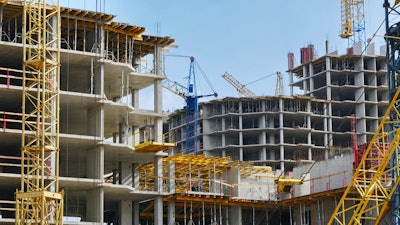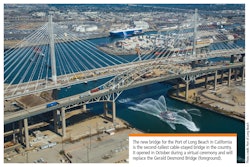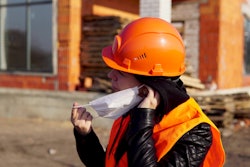 Single-family housing is currently booming, prompted in part by pandemic impacts.
Single-family housing is currently booming, prompted in part by pandemic impacts.As the nation starts to transition to a new year and a new presidential administration, we checked in with a panel of experts to see what they expect in 2021.
The news is mixed. While some sectors are red hot, such as single-home residential, others – office, retail, hospitality — are struggling as the nation deals with the multiple impacts of the pandemic. Both of these will be felt going into the next year.
We heard from three chief economists: Ken Simonson, Associated General Contractors of America; Anirban Basu, Associated Builders and Contractors; and Dr. Alison Black, American Road & Transportation Builders Association. Here’s what they told us:
Ken Simonson, AGC
“There will be some changes in appropriations and regulatory stance that will cut both ways for construction under a Biden Administration, assuming that Biden gets what he wants out of Congress, which is a huge question mark right now,” says Simonson.
 Simonson
SimonsonAlthough the pandemic has put an exclamation point on single-family housing construction, Simonson notes that the sector had already seen substantial improvements through most of 2019. This year, additional space needs are coming to the forefront as people continue to work from home and the opportunities of city life are now muted as we look for ways to avoid crowds.
“I expect single-family housing to post a close to 10 percent increase in construction spending over the next year,” Simonson says.
Multifamily housing, however, will either be flat or have a small decline. “But I wouldn’t be shocked if it stayed close to where it is,” he says.
Also experiencing upsides is construction related to renovation, endpoint distribution, data centers, medical-related and consumer product manufacturing, Simonson says.
Consumer expectations of home delivery are helping drive these trends. “People are not going to go back to their old shopping habits,” Simonson says. “They want the convenience of things delivered to their home.”
One possible bright spot on the building side might be K-12 schools. “At some point, we’ll be sending kids back to school and we have the same number of kids we had before,” Simonson says. “We need additional schools, expansions, and renovation of older school buildings. Schools look good from a demand standpoint.”
Helping this along will be steady residential property taxes, especially as escalating housing prices lead to higher tax assessments and receipts in a few years.
Although the pandemic has increased health care demands, those demands won’t result in immediate increases in health care construction, Simonson says. That will likely change, especially as telemedicine and Covid-19’s long-term impacts change how Americans consume health care.
 Commercial construction — especially in the retail, office and hospitality sectors — has suffered.
Commercial construction — especially in the retail, office and hospitality sectors — has suffered.
Anirban Basu, ABC
With 2020 almost behind us, contractors should be aware that there may be significant bumps ahead, Basu says. “I still believe that 2021 will be the worst year of the cycle for many contractors,” he comments. “You’ll see a lot of backlogs dry up, and contractors will be competing for the same work.”
 Basu
Basu“I think that the V recovery becomes a W and we head into a second recession,” he says. There is a wild card, however: “We might see something spectacular in terms of economic growth, particularly if we get an infrastructure component in any stimulus bill and a vaccine,” he says.
“This has been an economy of big losers and big winners,” Basu continues. “Retail, restuarants and hotels have taken it on the chin. At the same time, big tech has taken off and the online economy has gotten bigger.”
Considering the present headwinds, “construction has held up reasonably well this year,” Basu says. “But we’re down about 200,000 jobs compared to a year ago, even though the single-family housing market has been red hot.”
Traditional office construction will be quite bleak, Basu says, as companies adjust their thinking as to which employees still need to be in the office. Also on the downward trajectory are retail, restaurants, public buildings and higher education.
“There’s a lot of vacant retail space and that’s not a good recipe for new commercial construction going forward,” Basu says.
His advice to contractors: Focus on the segments that are set to grow. “Make sure that your banking and insurance relationships and your cash flow are strong enough so that you can see better days,” Basu says.
 Highway construction is expected to be down 6%.
Highway construction is expected to be down 6%.
Alison Black, ARTBA
“Looking at our preliminary numbers, we are expecting things to slow down in the coming year by about 6% overall,” Black says. Some segments – such as transit – will see more significant drops.
But this is on top of what turned out to be a good year for highway builders. “Highway work is on track to be very strong this year, up 8% more than last year.” Black says. Even though contract awards are not down significantly, she says, there is more uncertainty over the revenue shortfalls states are currently experiencing.
 Black
BlackStates are addressing this in different ways, Black says. Some are using bonds to keep their capital programs intact over the next year, some are cutting grants to local governments, and others are pulling back on projects. “Overall, we’ve tracked about $12 billion in project delays,” Black says.
When it comes to FAST Act highway funding reauthorization – which was postponed until next September — ARTBA is slow to count chickens. “Before there’s a federal commitment, we don’t include it in our models,” she says. “This year, for example, we never actually had a reauthorization bill in a conference committee.”
Black is hopeful, however, that the legislation that did go through the House and Senate this year will serve as starting point, since both called for a significant increase in investment.
Highway construction prospects boil down to how the federal aid program looks in the coming year, Black says. “That’s really going to determine how things look over the next few years because we know some states are going to pause and pull back on projects. A robust federal program would help offset that and promote growth in the market.”
The reauthorization is key since federal investment is about half of all revenues for state highway construction programs, Black notes.
“There are so many dynamics right now that will determine where we go over the next few years,” she says. “The federal piece is going to be really crucial to preventing any sort of long-term market downturn.”











